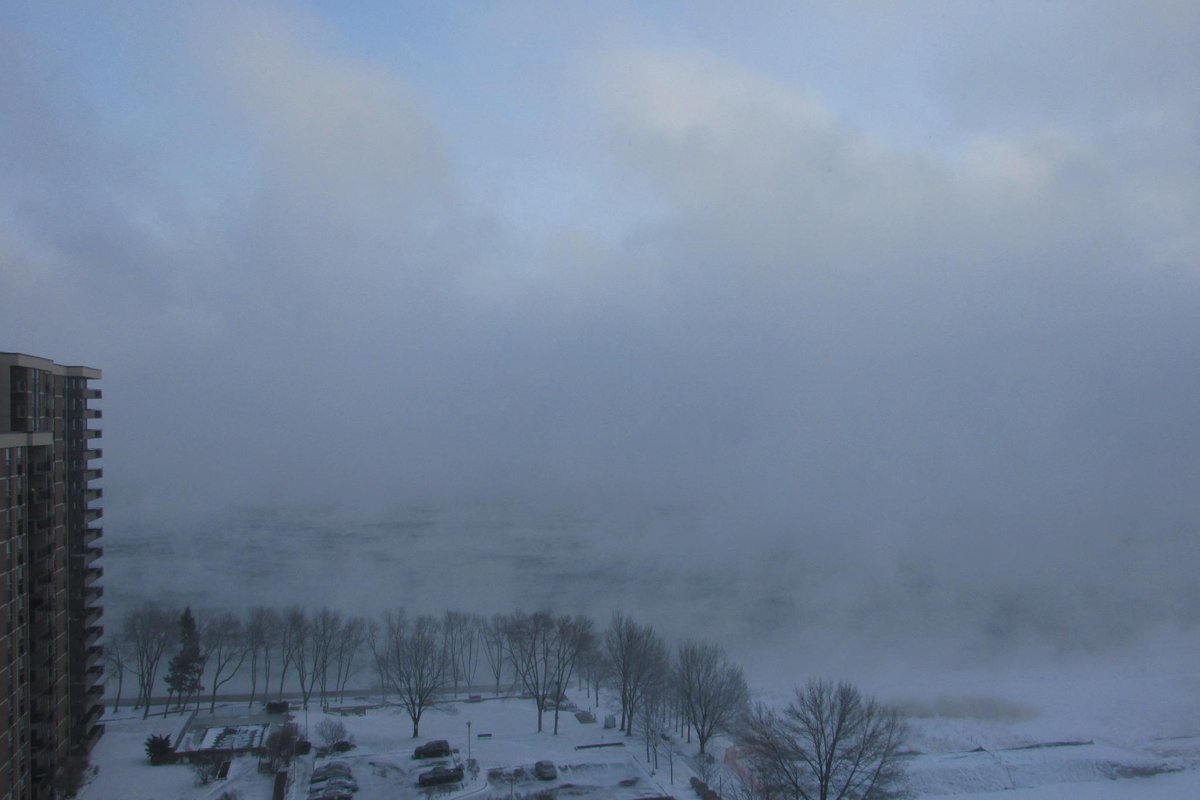This could well be considered a continuation of my last blog post, but does a fantastic job leading into some thoughts I've had recently on one of our great birding mysteries - grounded grebes and dead ducks!
I ended the previous post noting that the ducks off my condo had ended the evening, swimming through channels of slush as the waters continued to freeze. Some variation of this has been occurring for several days now, where patches of water open up and re-freeze due to wind, waves, water temperature etc. When I awoke the next morning, all of the remaining ducks (in a similar area) were squished into a small circle of open water that they had managed to keep open overnight.
We are on pace for our coldest February ever, and ice cover on the great lakes has rapidly increased; reaching ~85% in recent days. In fact, for the past week, there is a greater extent of ice coverage (all lakes combined) than any previous (recorded) year - in the same calendar week... This has initiated the mass wanderings and groundings of waterbirds - especially grebes. It is commonly stated that these birds have been "frozen out" of their wintering haunts due to this ice buildup, and inevitably crash somewhere they did not intend. Yet as I watched Lake Ontario this past weekend, I once again found myself questioning that explanation.
One of the more surprising observations, was various ducks (especially Red-breasted Mergansers, but also Long-tailed Ducks and White-winged Scoters) crash landing on the lake ice, seemingly at random. The above photo has 3 Scoters, and a lone Red-breasted Merganser (left edge) that had been drawn to the small circle of open water, yet just didn't make it. Sometimes the birds rapidly take flight, while others curl up and sleep for minutes to over an hour. A highly unusual place to take a nap, and this behaviour continued throughout the day.
In the evening, a strong offshore wind blew, and considerable patches of open water were made as great sheets of ice floated away.
While there was a number of open water "patches" during the day, I assumed the ducks must have been happy for this breakup to occur, and would return to a more normal routine the following day. If ice were truly the problem, perhaps the issue would be solved! Ungodly nighttime temperatures ensued...
At dawn there was considerably more open water than the previous day, but extreme temperatures had the surface freezing even with a strong offshore breeze. The majority of ducks were flying around and feeding, only showing expected levels of discomfort from the extreme cold (ice forming on their feathers). Yet almost inexplicably there was even more ducks randomly flopping down onto solid sheets of ice - making little attempt to reach water. At times I have seen birds "tricked" into sliding onto smooth/clear ice - potentially appearing like water, but this was not the case here. We're taking snow covered & thick lake ice. Later that morning, my attention turned to a grounded Long-tailed Duck in particular distress. A Great Black-backed Gull had arrived on the scene...
After some back-and-forth, I was shocked to see the Great Black-backed Gull take flight and start to leave! Surely this little duck isn't too much of a challenge? Yet the gull flew steadily away - before approaching a grounded Red-breasted Merganser! The Merg seemingly knew better, and immediately started running away, and quickly escaped the immediate danger. Then the gull flew right back to the Long-tailed Duck - WHICH MADE NO ATTEMPT TO ESCAPE! Why little duck, why?
Assuming the worst, I watched the gull increase it's attack and land more and more successful blows. The duck defended vigorously, but the gull knew what it wanted. The gull took flight, to do a rapid circle and attack from above - when the crazy duck finally TOOK FLIGHT (!) and ESCAPED!!! I had been convinced that it must have been incapable of flight, yet there she went...
So what did I learn from all of this? It's just a guess - but watching this Long-tailed Duck take a "Great Black-backed beating" - while clearly capable of flight - no more than 100 meters away from open water - I couldn't help but think that the ice coverage of the great lakes has nothing to do with the distress of these birds... In fact, it was the Oakville Painted Bunting that really put me onto this recent train of thought... (if you haven't heard, it died).
These birds (and the bunting) aren't dying because of ice cover - they're dying because the weather is horribly cold! Winter is a tough time to be a bird in Ontario, but record cold snaps in February are just pushing some of these birds beyond their limits... I don't really know how "cold tolerant" they are, but perhaps it is just too much for many individuals. This is really getting theoretical and doesn't really explain why the grebes are crashing onto roads, but there has been no obvious increase in Red-necked or Horned Grebes at open-water sites along Lake Ontario... If they really needed open water, I would have thought they could find it...
Perhaps there is no real explanation, but after watching the delirious behaviour of ducks crashing onto ice from my condo - with open water in sight - I really began to think that the extreme temperature had more to do with it, and the ice was simply a byproduct.















